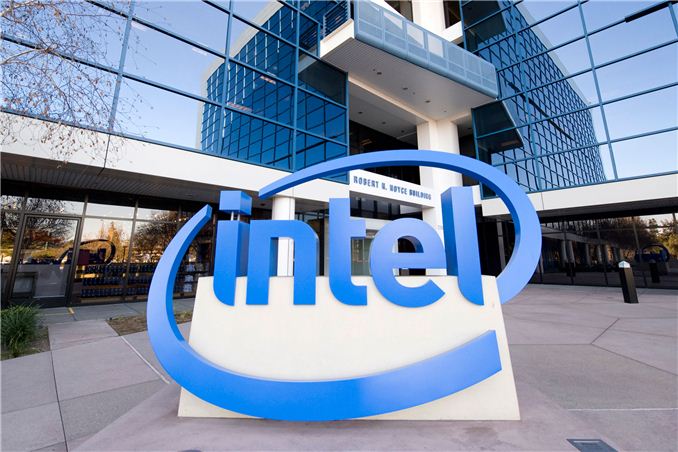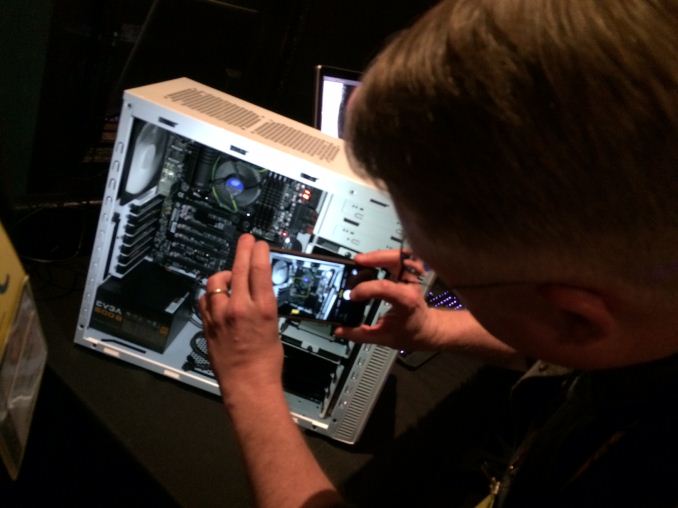Unlocked Socketed 65W Broadwell Iris Pro Desktop CPU Demoed by Intel at GDC15
by Ian Cutress on March 5, 2015 1:22 PM EST- Posted in
- CPUs
- Trade Shows
- Overclocking
- Broadwell
- Crystal Well
- Iris Pro
- Unlocked
- 65W
- 14nm
- GDC15

The next twelve months are set to be exciting times for the desktop space for Intel. While the current fifth generation mobile processors are coming to market, and the sixth generation being talked about in hushed tones, Intel demonstrated a PC that was listed as having a Broadwell desktop part (Broadwell-DT). The interesting culmination of factors surrounding this part is that it was listed as being socketed, unlocked and containing Iris Pro internal graphics.
The key elements here include the CPU being socketed (replaceable), unlocked (overclockable) and having Iris Pro, or Intel’s extended eDRAM segmentation usually under the Crystal Well name but with the much improved Generation 8 graphics architecture. While we have heard that an unlocked Iris Pro has been coming to desktop since March last year, very few details were given at the time, and the news today at least puts a TDP on such a part: 65W. Normally the high end SKUs from Intel are 77W to 85W, suggesting that this component may not in actual fact be an i7, or it could be an Iris Pro part but using one of the low power monikers such as ‘S’.
Image from Intel
The news also puts on a more firm date, so rather than ‘2015’ we get ‘mid-2015’, which puts it within the May to September timeframe. There are two important events occurring between those dates - Computex in June and the Intel Developer Forum in August, suggesting that Intel may aim for one of these events to have a formal launch.
Despite the launch of 14nm on the desktop, there has been recent talk of Intel’s next architecture, Skylake, also occurring within the year. This puts Intel in an interesting dynamic of releasing two different platforms for desktop within the same year. One could speculate and suggest that these will synergistically work in tandem, with Skylake-DT taking a segment and Broadwell-DT taking another segment. Where mobile fits into all this as well is difficult to tell, especially given the launch of Broadwell-U and Core-M within the past few months.
As much as we would like more information, it seems that the only thing we can tell is that the motherboard being used looks like an EVGA design due to the right angled power connector. Intel is also stating that the Iris Pro model will be great for all-in-ones (no argument there) which could also feature its RealSense camera, enhancing compute power and interactivity. It would be interesting if a socketed Iris Pro was truly aimed at the AIO market, but then such a SKU would not need to be unlocked. Unlocking for the purposes of overclocking is naturally aimed at the desktop market, although usually for gamers with discrete GPUs rather than Iris Pro.
Naturally we want to get our hands on a sample for review. Ryan is at GDC this week so if he gets a chance to spend a few minutes with the system it would be interesting to hear what they actually represented in the demo as well as more information about the system itself.











78 Comments
View All Comments
Mushkins - Friday, March 6, 2015 - link
It depends on your use case really. A desktop chip at a 65W TDP with Iris Pro would be phenomenal for an HTPC that also does more casual gaming. The thing really holding back those types of builds has been integrated graphics performance, and Iris Pro really steps up their game in that department.Though you're right, Iris Pro availability is moot if you're building a traditional gaming rig because you're going to disable the IGP anyway.
Kvaern2 - Friday, March 6, 2015 - link
Doesn't it boost Quick Sync performance as well?That might add value to some, in an i7 anyway.
darkfalz - Sunday, March 8, 2015 - link
Only if they find a way to enable iGPU for QS withtout Virtu / 2nd monitor other hacky workarounds.OFelix - Friday, March 6, 2015 - link
I am waiting for Broadwell or Skylake Iris Pro desktop part before I upgrade my aging system.I want to a system with Intel iGPU as well as boot disk based on PCIe SSD drive (maybe with NVMe?)
Intended use is a dual boot Windows & Linux general purpose machine to keep runing for the next 10 years.
Should I go with Broadwell or wait for Skylake?
Ammaross - Friday, March 6, 2015 - link
I'm sitting on my hands until Skylake.As for "the next 10 years" part, you'll be lucky if your motherboard lasts that long. Plan on 4 or 6-year upgrade cycles, unless you think your IDE connectors, AGP slot, and floppy drive from 2005 are still relevant...?
Kvaern2 - Friday, March 6, 2015 - link
That really depends on the user case.We have old Conroe (2006) based PC's at work which having been upgraded to Win 7, SSD and more RAM over the years are still more than adequate for running browsers, Office365 and several business specific applications.
purerice - Friday, March 6, 2015 - link
(to the original question) It seems like most Broadwell will NOT be desktop so if you want a desktop, Skylake may end up being your only viable option. Even if Broadwell desktop did exist, I personally would wait for Skylake anyway (and I am).Similar here. All C2Duo iMacs except for 2 AMDs and 1 SB i3 (the "workhorse"). Average age, 7-8 years. Mice are all Microsoft Intellimouse, vintage 2000,2001, and the printers all Canon, vintage 2007-2009. They are perfect for financial/accounting software+Excel.
The iMacs run Yosemite (10.10) slowly, but are fine in SL (10.6) or Windows.
Maybe others have less luck with hardware longevity and maybe 10 years is too much to expect, but in terms of performance, 10 years is not too much to hope for. For 90% of what we do, the bottleneck in performance is the user or waiting for external data to input.
That said I haven't had a "gaming" device since a PS2 or a 600MHz Athlon w/ Geforce2 GPU and would love to get my hands on a good FPS or Skyrim or hundreds of other games I have been deprived of the past 11 years.
jeffry - Friday, March 6, 2015 - link
I agree on that one. I still have an old Yonah Core Duo running Lubuntu Linux on my Laptop. Its has its second fan, second hdd and 2 GB of RAM. Works fine for Business (Email, Office, Internet).phoenix_rizzen - Friday, March 6, 2015 - link
Hey, I have an Athlon64 system running with an AGP video card, IDE harddrive, and floppy drive (although never used) connected to our 27" CRT TV via component video, thank you very much! Runs Windows XP, Google Chrome, and the Plex Web Client just fine. It's not on 24/7, but it makes watching shows in the bedroom easy enough.Just waiting for the hardware in that system to actually die before the TV is moved into the kids' room for use with all the old consoles (NES, SNES, some LeapFrog stuff, Wii, etc). Hoping it lasts another 2-3 years, though.
jeffry - Friday, March 6, 2015 - link
Hehe, amazing. I also have one of these. Its an AMD Athlon XP (not 64;), those were the first 64 bit AMDs) 'Barton' running a Ubuntu File Server (Samba). Works like a charm...